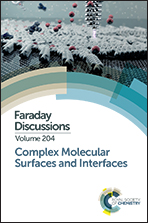Physical and chemical model of ion stability and movement within the dynamic and voltage-gated STM tip–surface tunneling junction†
Abstract
The interaction and mobility of ions in complex systems are fundamental to processes throughout chemistry, biology, and physics. However, nanoscale characterization of ion stability and migration remains poorly understood. Here, we examine ion movements to and from physisorbed molecular receptors at solution–graphite interfaces by developing a theoretical model alongside experimental scanning tunneling microscopy (STM) results. The model includes van der Waals forces and electrostatic interactions originating from the surface, tip, and physisorbed receptors, as well as a tip–surface electric field arising from the STM bias voltage (Vb). Our model reveals how both the electric field and tip–surface distance, dtip, can influence anion stability at the receptor binding sites on the surface or at the STM tip, as well as the size of the barrier for anion transitions between those locations. These predictions agree well with prior and new STM results from the interactions of anions with aryl-triazole receptors that order into functional monolayers on graphite. Scanning produces clear resolution at large magnitude negative surface biases (−0.8 V) while resolution degrades at small negative surface biases (−0.4 V). The loss in resolution arises from frequent tip retractions assigned to anion migration within the tip–surface tunneling region. This experimental evidence in combination with support from the model demonstrates a local voltage gating of anions with the STM tip inside physisorbed receptors. This generalized model and experimental evidence may help to provide a basis to understand the nanoscale details of related chemical transformations and their underlying thermodynamic and kinetic preferences.
- This article is part of the themed collection: Complex Molecular Surfaces and Interfaces

 Please wait while we load your content...
Please wait while we load your content...